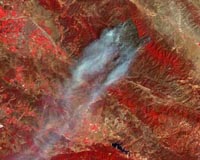 |
Guildford UK (SPX) Aug 21, 2009 Remote sensing solutions provider DMCii has won a 3.9 million euro contract from the European Space Agency (ESA) to acquire satellite imagery of sub-Saharan Africa. The data will constitute an essential part of the European funded Global Monitoring for the Environment and Security (GMES) programme and the contract includes changes to the company's systems to interface with the ESA image catalogue. Dr Volker Liebig, Director of Earth Observation Programmes commented "The DMC constellation delivers multi satellite imagery for monitoring rapidly changing phenomena, complementing the data that will be made available by the ESA Sentinel missions." DMCii has already begun the campaign which will acquire 32m and 22m imagery using the DMC constellation until September 2010, by which time coverage of all 48 countries in sub-Saharan Africa will be completed. Paul Stephens, Sales and Marketing Director commented, "We are in the unique position of being able to provide complete high resolution coverage of such a large area within a tight timescale. Our multi-spectral imagery will contribute greatly to Europe's knowledge of forest resources and food security in sub-Saharan Africa." Imagery will cover the vast Congo Basin forest area which, as the second largest tropical rainforest after the Amazon Basin, is an area of significant concern in the fight against deforestation and carbon emissions. The DMC images will enable regular monitoring of deforestation, thus improving governance of this crucial forest resource. Data from the DMC constellation will also enable more frequent and detailed information to be compiled about agriculture and land cover changes across the African continent, which will support initiatives to improve food security for the region. Sub-Saharan Africa is a diverse region with climatic extremes ranging from the arid deserts of Namibia and drought-prone Ethiopia to the diverse tropical rainforests of the Congo Basin. DMCii will make use of the multiple satellites available within their constellation to optimise the acquisition and selection of cloud-free imagery. Calibration techniques developed by DMCii ensure that the difference in radiometry between images acquired by the different satellites is less than 0.5%. This ensures that the images can be used together for accurate and repeatable scientific measurements. In particular, the use of several satellites coordinated in a constellation enables daily revisit, which is vital in rapidly changing situations such as deforestation, floods and fires. The Global Monitoring for Environment and Security (GMES) initiative is funded by the European Commission (EC) and ESA. It was established to fulfil the growing need amongst European policy-makers for accurate and timely information services to better manage the environment, understand and mitigate the effects of climate change and ensure civil security. Share This Article With Planet Earth
Related Links DMC International Imaging Earth Observation News - Suppiliers, Technology and Application
 Satellite Imagery Shows Forest Fire Devastation
Satellite Imagery Shows Forest Fire DevastationLondon, UK (SPX) Aug 17, 2009 Satellite imagery from the recently launched UK-DMC2 satellite shows forest fires in the Los Padres National Forest east of Santa Maria at 11:10 local time on the 12th August. California is currently experiencing widespread forest fires, which has lead to evacuations in two areas. Bloomberg has reported that more than 1,900 fire fighters were battling the blaze that has burned at least 48 ... read more |
|
| The content herein, unless otherwise known to be public domain, are Copyright 1995-2009 - SpaceDaily. AFP and UPI Wire Stories are copyright Agence France-Presse and United Press International. ESA Portal Reports are copyright European Space Agency. All NASA sourced material is public domain. Additional copyrights may apply in whole or part to other bona fide parties. Advertising does not imply endorsement,agreement or approval of any opinions, statements or information provided by SpaceDaily on any Web page published or hosted by SpaceDaily. Privacy Statement |